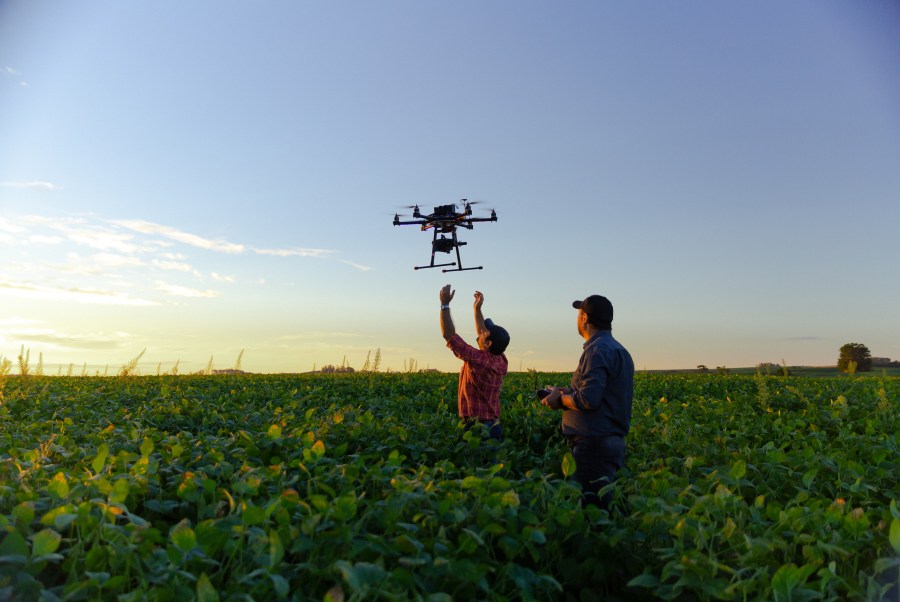From farm to fork, thanks to … AI and robots?

Much of the western United States dealt with scorching temperatures over the past week, with some parts of California reaching more than 110 degrees Fahrenheit. That state is suffering a multiyear drought, and some residents are allowed to water their gardens and lawns only one day per week.
Texas, Nevada and New Mexico are also experiencing severe droughts, according to the U.S. Department of Agriculture. So, farmers have to be especially careful about how they use precious resources like water.
Marketplace’s Kimberly Adams spoke with Jill McCluskey, a professor of sustainability at Washington State University’s School of Economic Sciences, about how smart tech in agriculture can help. The following is an edited transcript of their conversation.
Jill McCluskey: It seems like farmers and producers are almost turning into artificial intelligence engineers. They are using smart crop monitoring and drones, satellites and GPS to become more efficient and reduce costs.
Kimberly Adams: What are some of the issues, or industry concerns, that are really pushing innovation in agriculture technology right now?

McCluskey: I would say the two biggest concerns for agriculture are the availability of labor and the availability of water. Artificial intelligence, robotics and machine learning can help with both of those issues. And so as we have more robotic harvesting, for example, and autonomous farm machinery, we can use less labor. And this also is probably good for the workers, that it reduces the need for them to engage in some of the menial and dangerous work.
Adams: What does a farm robot look like?
McCluskey: It depends on the crop. So for lettuce, for example, it might have wheels on both sides that go over the row of lettuce and can harvest. But for apples, it might have a raising platform that can help harvest the apples. It’s just different for each crop, they would be different.
Adams: How much of farm work can be automated at this point?
McCluskey: A lot of it can be automated. If you think about [it], we have self-operated machinery that’s connected to sensor data and GPS data. And so you can imagine a combine without a driver harvesting. The more challenging part in terms of harvesting is for the delicate crops that are very labor-intensive. So an example is the raspberry. So if you think about it, a raspberry is very delicate. It’s really hard for a robot to pick it without damaging the fruit.
Adams: Is there any technology in development to solve that problem?
McCluskey: They’re currently working on it. I know for some products, they’re using vacuums to pick the fruit instead of pinching it like a finger would do. They actually vacuum the fruit off the bush.
Adams: There is, of course, this bad drought happening out West this year. And water issues are just an ongoing problem for many parts of this country. How is technology working to address the water shortages many farmers are experiencing?
McCluskey: Sensors that are smart connected and satellites and drones can provide in-ground data of the moisture level. And so the water can be more efficiently applied. In the past, in the West we’ve often had just irrigation of fields. And so water is not used in an efficient way. And agriculture does use a large proportion of water. And as water gets more scarce, we need to use it optimally.
Adams: How affordable are some of these new technologies for farmers?
McCluskey: Affordability is still an issue. But as we continue to develop cheaper versions of it, I think it’ll be adopted in a more widespread way. And often, berry farmers and those types of farmers tend to be smaller than, say, a huge wheat farm or a huge soybean farm in the Midwest. So those farmers with huge fields have been able to invest in really expensive farm machinery, but the smaller operators can’t. So that is an issue; it needs to get cheaper over time.
Adams: Already, large agricultural companies have a big advantage over the smaller farms. How will the fact that they can invest in these technologies and the smaller farms can’t affect that dynamic moving forward?
McCluskey: It definitely puts the large farms at an advantage. And the small farms — they probably would be more likely to produce organic crops and other crops that have more value added. And they could specialize in those types of crops in order to survive. But I think it is an issue that as labor gets more expensive, and the robotic technology is also expensive, it’ll be harder for the small farms to compete.
Adams: Labor shortages in the agricultural sector have been an issue for some time now. And I wonder how that is affecting the urgency of this push to automation.
McCluskey: I think it definitely has affected the urgency. So as labor gets more expensive, we come closer to robotics that are essentially a backstop technology, so then it’s more expensive. But as the price of labor hits that backstop technology, it might actually be cheaper to invest in robotics for harvest. And at the same time, I think that it becomes a priority for research and development as labor becomes more expensive.
Adams: So with all this new technology, what happens to the workers who remain?
McCluskey: I think in the future, there will be less need for agricultural workers — the traditional work that they did of harvesting crops, picking crops. So we would hope that some of those people would be trained to run some of the machinery. They would be trained to do work that is more satisfying and socially sustainable.
Adams: How important is sustainability in the development of all this technology in agriculture?
McCluskey: I think sustainability really drives the use of technology in agriculture. So the use of technology will help producers be more sustainable in their use of water, which is such a difficult problem that we’re facing as a society, and also be sustainable in terms of workers so that they will need fewer workers to do the really hard and dangerous tasks.
The future of this podcast starts with you.
Every day, the “Marketplace Tech” team demystifies the digital economy with stories that explore more than just Big Tech. We’re committed to covering topics that matter to you and the world around us, diving deep into how technology intersects with climate change, inequity, and disinformation.
As part of a nonprofit newsroom, we’re counting on listeners like you to keep this public service paywall-free and available to all.
Support “Marketplace Tech” in any amount today and become a partner in our mission.


















